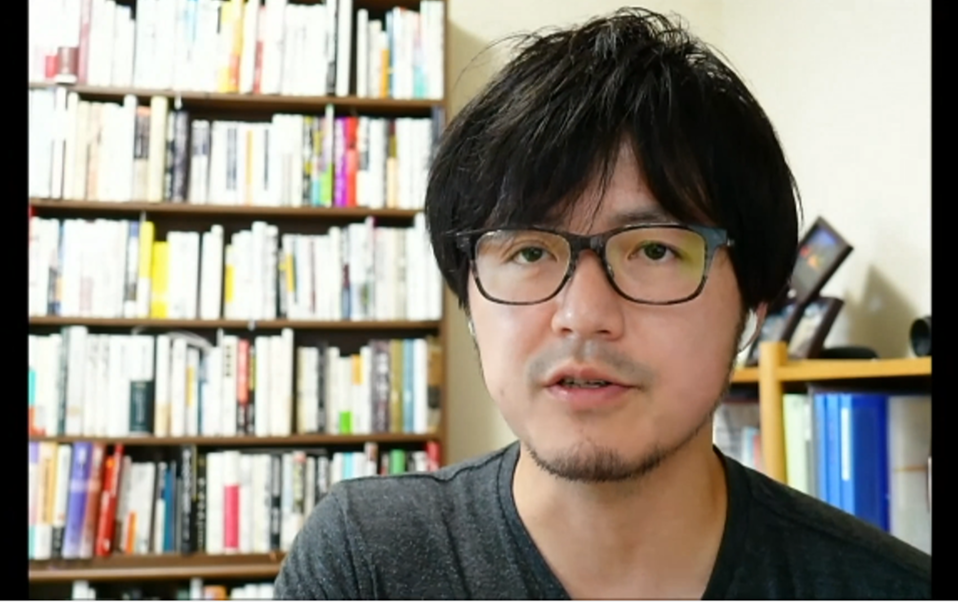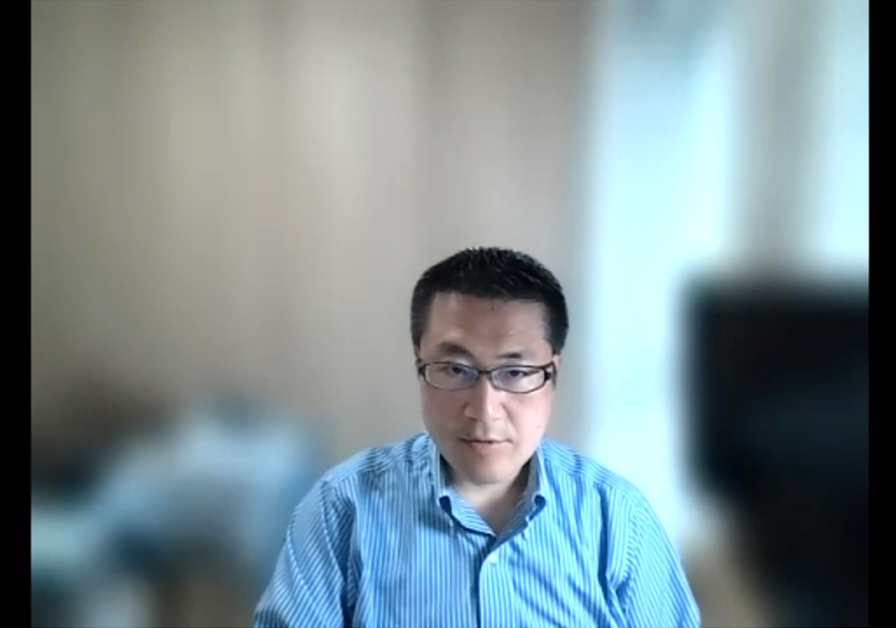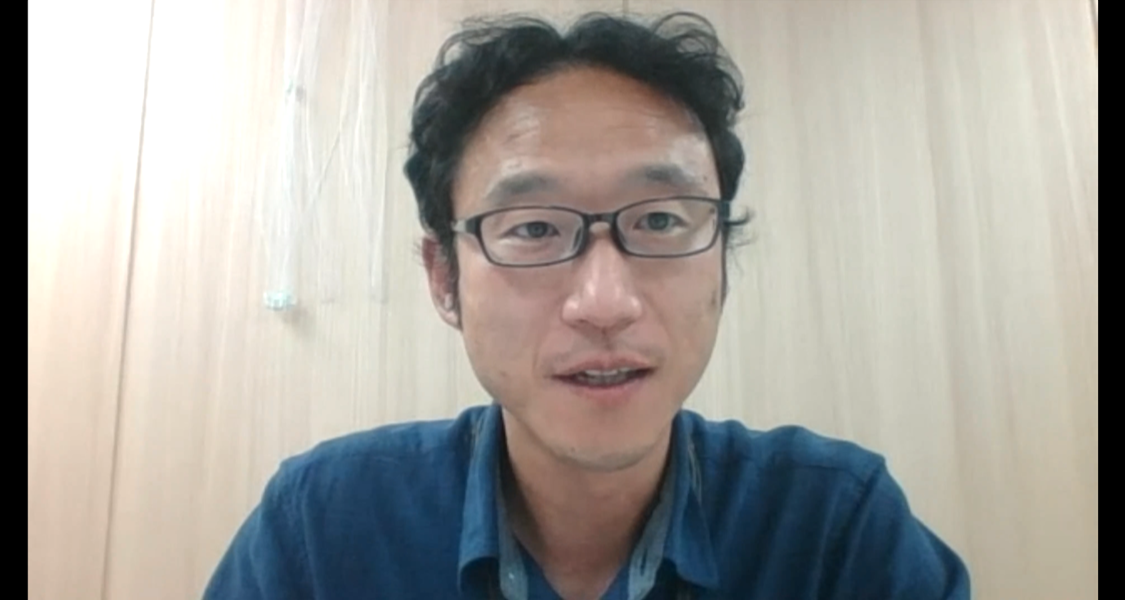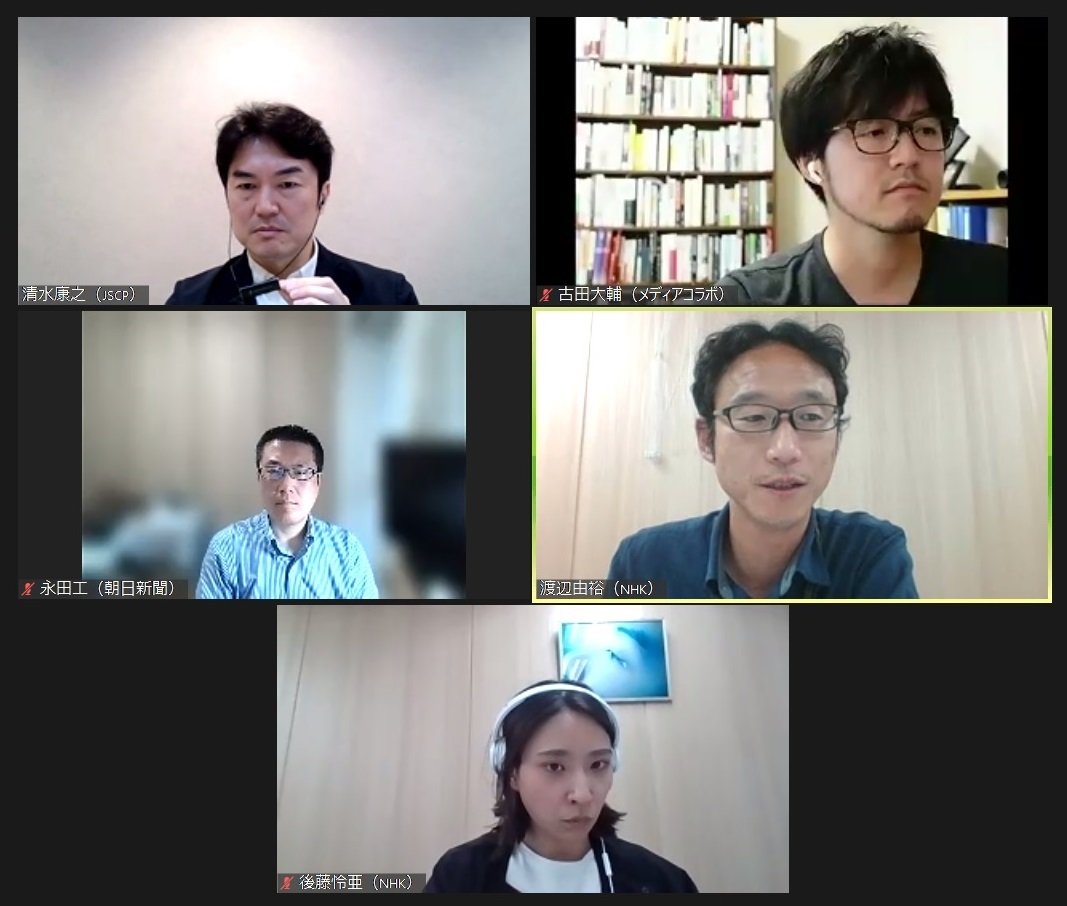

Recommendations & Raising Awareness
1st Study Session on Suicide Coverage “Between Freedom of the Press and Suicide Risk” - Report
August 10, 2021
The Japan Suicide Countermeasures Promotion Center (JSCP) held the 1st study session on suicide Coverage “Between Freedom of the Press and Suicide Risk” online from 2:00 p.m. to 4:30 p.m. on Sunday, June 20, 2021. In July and September of 2020, after a series of celebrity suicides, there was a spike in the number of suicides generally immediately afterwards. One year on, this session was limited to those involved in the media in order to provide a place where those involved can have honest discussions, as the number of suicide reports is expected to increase again before the one-year anniversary. There were 110 participants nationwide who took part, including staff from major and local newspapers, tv, internet, and magazines. Mr. Daisuke Furuta, journalist and representative of media-collab, Mr. Ko Nagata, deputy general manager of the Asahi Shimbun's Social Affairs Department and Regional News Department, and Mr. Yoshihiro Watanabe, chief producer of NHK’s Special Content Development Center, gave lectures and discussed with the participants their concerns and questions about suicide coverage.
Opening Remarks
Yasuyuki Shimizu, Representative Director of JSCP
JSCP Representative Director Yasuyuki Shimizu gave the opening speech, explaining the trend of the number of suicides in 2020 and the impact of suicide coverage, based on JSCP's analytical data amongst other information.
First, he showed the trend of suicides by month (Figure 1), and reported that the number of suicides nationwide increased significantly in July and October, after decreasing considerably from April to June due to the COVID-19 pandemic. Next, showing the number of suicides per day (Figure 2, showing the difference between the projected number of suicides in 2020 based on the numbers for the past five years, and the actual number of suicides), he explained out that “detailed data showed a sharp increase in the number of suicides on July 19, the day after the suicide of a famous male actor was reported, and on September 27, the day the suicide of a famous female actor was reported. It is clear that the number of suicides spiked immediately after the reports of famous people's suicides.”
Figure1
Figure2
In addition to the JSCP, suicide countermeasures non-profit Life Link, of which he is also a representative, received many calls from the public since the suicide was reported, including “I'm afraid that I might take my own life after seeing the news of celebrities' suicides” (Female 30s), and “I want to commit suicide like them and be at ease" (Male 40s). He added that “We believe people who were suffering from worries and anxieties from COVID-19 related to work, life, relationships, etc. may have been encouraged to suicide by the coverage of celebrity suicide.”
He also reported that during fiscal year 2020, JSCP issued a total of nine reminders to media outlets (a total of 82 companies and 242 media outlets) to report on the death of celebrities by suicide in accordance with the WHO's Preventing suicide: a resource for media professionals, update 2017. “I do not mean to suggest that coverage of suicide should not be done at all because of this effect. Based on my experience as a news director at NHK, I believe that it is the responsibility of news journalists to provide information about suicides, why they are happening, and what kind of support is available,” he said. “However, depending on how the information is reported, the reality is that it may drive the some people towards suicide, so I think it is necessary to carefully examine the risks of reporting. We experts in suicide prevention should not unilaterally impose (the guidelines), but we would like to think together with everyone about what kind of reporting should be avoided or what is possible.”
Are media reports triggering suicides? Suicide records and a numerical analysis of 300,000 people by Mr. Hiroshi Abe in JSCP analysis team
Mr. Hiroshi Abe of the JSCP Analysis Team gave a lecture titled Are media reports triggering suicides? Suicide records and a numerical analysis of 300,000 people. JSCP, a research and study corporation designated by the Minister of Health, Labor and Welfare responsible for analyzing and studying suicide, and has conducted analyses using data from the original statistics of approximately 300,000 people who died by suicide over the past 12 years. Although only rough data such as the number on a monthly basis had been released, it is now possible to conduct a more detailed analysis of the date, time, and cause. Mr. Abe reported on the results of his analysis of the data from the suicide statistics sourcebook, using advanced mathematical analysis tools such as big data analysis and machine learning.
What the daily data has revealed
Dr. Abe compared a recently published graph of the number of suicides per month, and a graph of the number of people infected with the COVID-19 in Japan (Figure 3), pointing out that “since the timing of the rise in the graphs appears to overlap, it might be reported that suicides are increasing due to the COVID-19 disaster. However, a more detailed look at the daily data reveals that the suicides of a famous male actor in July and a famous female actor in September are the major factors pushing up the number of suicides.” In particular, the results of the analysis on the impact of the female actor showed that within 10 days of her suicide (including the day of), approximately 200 people died possibly as a result of her suicide and the resulting media coverage, prompting the question that “although many factors can contribute, for those with suicidal ideations, is it likely that seeing a report of a famous actor's suicide is a trigger?"
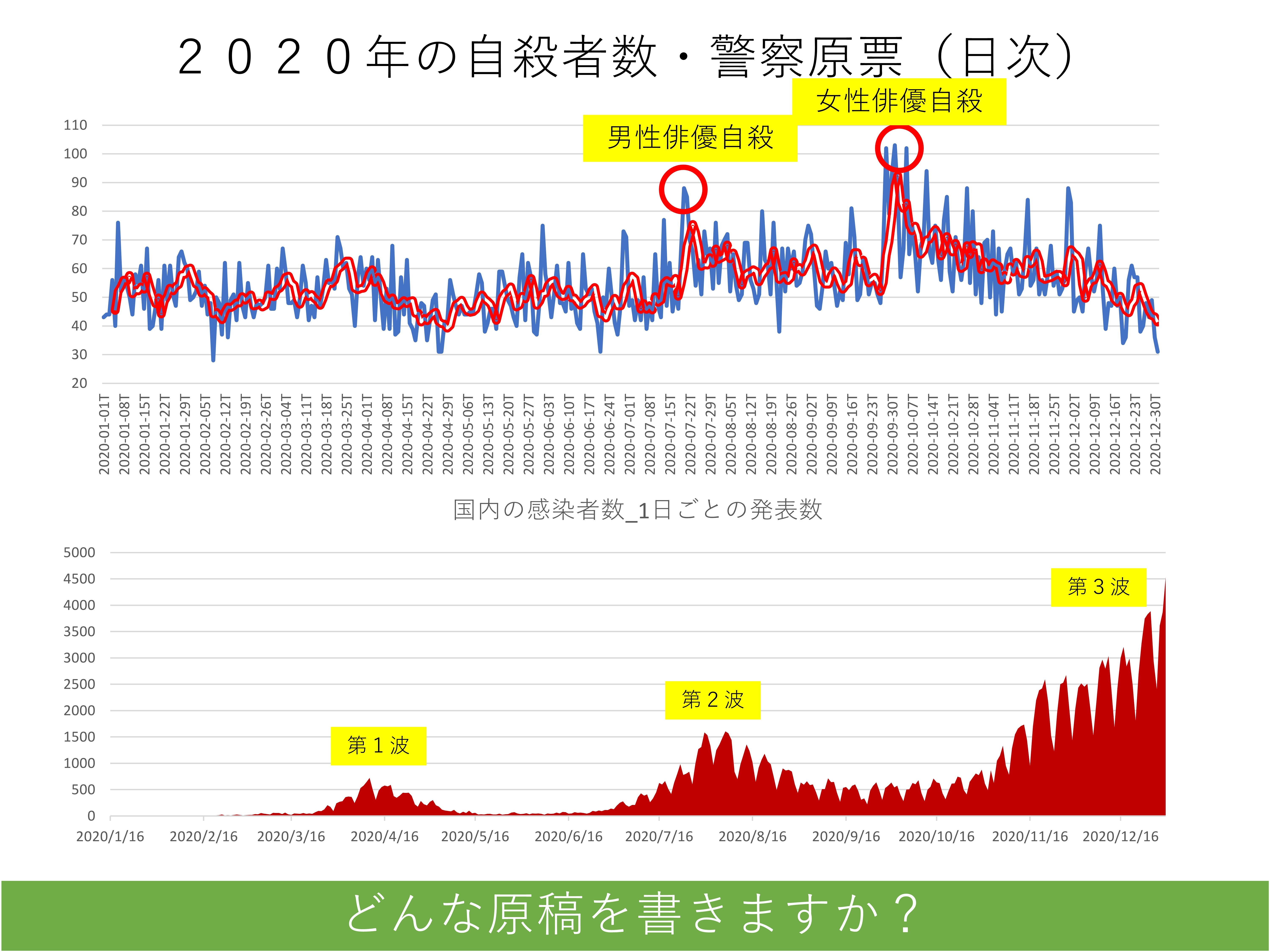 Figure3
Figure3
What the time-series data has revealed
Starting from the time when the suicide of a famous actor was reported at around 3:00 p.m. on Saturday, July 18, the data on the number of suicides, number of Twitter posts, and volume of suicide reports were all overlaid and analyzed on an hourly basis. As a result, immediately after the suicide was reported, there was a burst (sudden upsurge) of three words on Twitter: the full name of the male actor, "suicide," and "hanging. The number of Twitter posts containing the words "I don't want to do XXXX", "wrist cut", "want to die", "lonely", and "help me" peaked at different times during the night when the commotion was calmer, and the number of suicides increased at dawn (Figure 4).
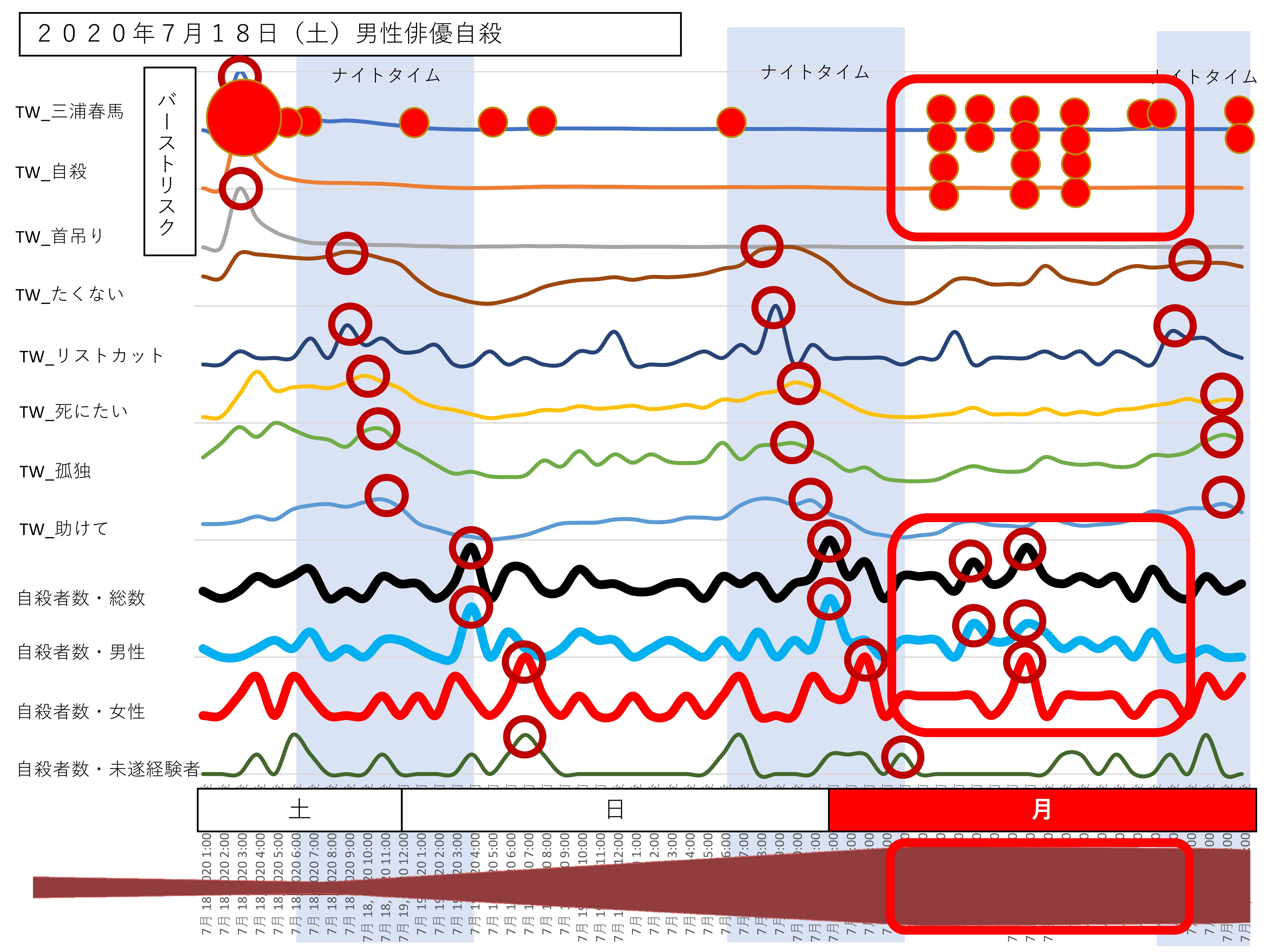 Figure4
Figure4
The following day, the 19th, was a Sunday, so the volume of suicide reports did not increase significantly, but during the nighttime, Twitter posts showed a similar trend to the previous day, followed by an increase in suicides. On Monday the 20th, the situation changed drastically. There was a large number of suicide reports concentrated in the morning, and the number of suicides increased during the hours coinciding with these reports. “This past Monday turned out to be a rare day with many suicides. The suicide of a male actor was heavily covered by various TV shows, and the location and means of the suicide as well as the character of the deceased were conveyed to the viewers in a sympathetic manner. It is necessary to carefully examine whether this has led to subsequent suicides,” said Abe, “Looking at the number of suicides by day of the week, it can be seen that the risk of suicide is extremely high on Monday (Figure 5). Those who are in charge of Monday morning programs need to be especially careful to avoid the risks of increasing suicide as a result of news coverage.”
Mr. Abe concluded by saying “A large number of news reports on suicide may not necessarily lead to a large increase in suicides. The number of suicides is influenced not only by the amount of news coverage, but also by a combination of factors such as how much the news spread on social networking sites and how many people searched for it, so there isn’t a need to stop all suicide reporting. However, the data analysis revealed that we can reduce suicides by taking a few precautions, such as not spreading the news excessively on social media and refraining from reporting at night and on Monday mornings, when anxiety is more likely to be amplified.”
Lecture #1 - Current Status and Issues in Suicide Reporting in the Digital Age by Daisuke Furuta, Journalist/Representative of media-collab
Based on the experience as a reporter for the Asahi Shimbun newspaper and then as the first editor-in-chief of the online media company BuzzFeed Japan, Mr. Daisuke Furuta said as a journalist “Although this is often thought of as the responsibility of the Internet media, the origin of the information being spread is mass media reporting, and it is important to recognize and take responsibility for the fact that newspapers and TV are also Internet media.”
What was the most spread news about suicide last year?
Mr. Furuta pointed out that the most widely spread celebrity suicide report on the Internet during 2020 was a tweet of breaking news from a commercial broadcaster (with the news video attached). The data showed that the tweet had 57 million estimated impressions (the number of people who saw the tweet) and 113,600 total engagements (the number of people who retweeted or liked the tweet). The most shared was the comment section of the same breaking news story distributed through yahoo news (about 260,000 shares), followed by the body of the same article (about 198,000 shares). He said that these situations show that breaking news from newspapers and television have an overwhelmingly strong influence on the Internet.
Why do newspapers and television reports have such a strong influence in the digital age?
Why are newspapers and television so influential in reporting on suicide, especially in an age when there is so much information available on the Internet?
Mr. Furuta presented the news flow as follows:
(1) Police and firefighters learn of the event
↓
(2) Information is announced to the Police Press Club, which is composed of mass media such as newspapers and TV.
↓
(3) Reporters in charge of the incident at member news organizations turn the information into a story and publish it as a flash report.
He also pointed out that only the mass media, which can join the press club, can get information from the police, and that the mass media is the starting point for reporting incidents (suicides). The breaking news articles are then massively disseminated via push notifications by major aggregators that collect and distribute the articles, and at the same time, they are posted on Twitter and other social media sites on the accounts of news companies to spread the sharing. Aggregator sites then create content by quoting articles and rumors, in turn creating misinformation. He questioned if mass media was aware of the great responsibility it has to the internet.
Current Status and Issues of Suicide Reporting
On July 19, 2020, the day after the famous actor's suicide was reported, Mr. Furuta published an article examining whether the responses of media companies' responses were in line with the “Do's and Don'ts” of the WHO suicide reporting guidelines (https://news.yahoo.co.jp/byline/furutadaisuke/20200719-00188898). "In recent suicide reports, several companies have responded to the guidelines by including contact information at the end of the article or in related links. On the other hand, there were some reports that may have fallen under the category of excessive reporting, going against the WHO guidelines," he said. Suicide reports were often forcibly pushed through to smartphones via push notifications by aggregators, starting with breaking news from mass media, the problem being that some media outlets reported detailed information about the suicide location and means, which spread quickly through social media and aggregator websites.
Mr. Furuta expressed his understanding of the efforts being made by the media companies, but pointed out, "However, I believe that there is still more that can be done in certain areas.” He mentioned a US suicide countermeasures group had, based on their discussion with journalists, created Reporting on Suicide, a detailed guideline to reporting on suicide. Citing examples of news reports that illustrated the details of a victim's suicide notes, he said, "As the concept of reporting expands in the digital age, it will be important in the future to provide reporting guidelines not only to mass media but also to online media and bloggers. He concluded by saying, "I think we need to think properly about why we report on suicides and to what end we share that information.”
Lecture #2 - Preparing our own guidelines and on-site initiatives in news reporting by Ko Nagata, Asahi Shimbun Social Affairs Department and Vice President of Regional Reporting Department
Mr. Nagata works at the forefront of news reporting as the deputy director (the "desk") of Asahi Shimbun's social and regional news department. He has been involved in incident and accident reporting for many years and was in charge of the news desk covering the Metropolitan Police First Investigation Division, and digital editorial desk prior to assuming his current position in 2019. Based on his own experience of being involved in both incident and digital reporting, he spoke about the process of Asahi Shimbun creating its own guidelines for suicide reporting.
Suicide reporting as incident reporting
Mr. Nagata said that “suicide reporting” is positioned under the category of “incident reporting” at Asahi Shimbun, and related discussions are held by the Incident Reporting Subcommittee (consisting of the desks in charge of incident reporting, digital reporting, and paper publications at Asahi’s four headquarters). The discussions are then reflected in a booklet that outlines the company's reporting guidelines for covering and reporting on incidents, which is revised every few years. Although suicide was originally regarded simply along the lines of "real-name reporting or anonymous reporting" in the section on "suicide, heart attack, abuse, and other domestic incidents," it has undergone significant revisions since then in 2012 and 2018.
What was the occasion and how was it revised?
Mr. Nagata explained the major revision of the reporting guidelines on suicide as follows.
In the 2012 revision, in addition to the existing items in the guidelines, it was indicated that when suicide is widely reported, attention should be paid to the possibility of copycat suicides caused by the news reports, especially in the case of suicides of celebrities and youths, which are considered to have a high risk of causing subsequent suicides, as well as not publishing photos of suicide notes that show any handwriting. Posting the contact details for consultation services alongside the article is effective in preventing further suicides. The impetus for this revision came from an article in the Asahi Shimbun evening edition, July 2011, in which Mr Shimizu (then a counselor in the Cabinet Office) reported that the sharp increase in suicides in May was due to the influence of the suicide of a female celebrity. Mr. Shimizu pointed out to us that it was not the suicide itself, but rather the reporting on which triggered the subsequent copycat events, which was then later discussed at Asahi. In response, Asahi Shimbun corrected the article, revised the headline of the online article, and removed the initial report of the female celebrity's suicide from the related links. An article on the company's suicide reporting direction and the fact that it was revising its suicide reporting guidelines, with a focus on the goal of non-provocative reporting, was published along with an interview with Mr Shimizu, who stressed the need for media companies to create their own suicide reporting guidelines.
However, in December 2017, when the Asahi Shimbun Digital published the full text of a suicide note in an article reporting on the suicide of a famous South Korean idol, it was criticized both internally and externally for its seemingly odd publication. Although the article was removed about an hour after it was published, a public editorial meeting composed of outside experts also pointed out the need to reinforce messages around reporting on suicide. In response to this, the Incident Reporting Subcommittee met again and updated the 2012 edition, with the new 2018 revision adding to "use caution when dealing with suicide notes," and other considerations related to suicide reporting, which has a particularly large impact on young people. While the WHO suicide reporting guidelines state that "suicide notes should not be published," our guidelines added a sentence stating that "there are cases where the social significance of publishing suicide notes outweighs the risk of inducing suicide, and it is necessary to make decisions while carefully considering the public interest and suicide risk.
Current efforts of Asahi Shimbun
Asahi Shimbun has created and revised its own guidelines on suicide reporting, with initiatives such referring to the WHO Suicide Reporting Guidelines at the beginning of the series You Are Important, which was published in April 2017 and aimed to prevent suicide amongst children.
They are also continuing their efforts to examine whether media companies, including their own, have reported on the 2020 string of celebrity suicides in accordance with the WHO reporting guidelines. Mr. Nagata said, "Over the past decade or so, we have continued through a trial-and-error process based on the challenges we face in actual news reporting, and we continue to do so today. If there are any areas that also need to be revised in the future, we would like to incorporate them into our company guidelines too."
Lecture #3 - On projects focused on the Papageno effect as a suicide deterrent by Yoshihiro Watanabe, chief producer of Special Content Development Center, NHK, Japan Broadcasting Corporation -
Mr. Watanabe, Chief Producer of NHK’s Special Content Development Center, gave a presentation on the TV and digital project I am Papageno - The story of living with the desire to die, including the background to its launch, an overview, and assessing its effectiveness.
Mr. Watanabe has for a long time been involved in the production of welfare programs, and whilst reporting on the issue of suicide, he created a special website Facing Suicide around 2008, where viewers could share their thoughts, and began to receive many voices frankly describing their feelings of wanting to die. The number gradually increased, reaching 2,000 to 2,500 cases per month, or about 50,000 cases in total. In listening to these voices, Mr. Watanabe began to feel that there are very few places where someone can freely air their feelings of wanting to die or suffering to the point of wanting death. He started TV for Surviving in 2014, where young people with suicidal thoughts talked in the studio. Due to the high number of teenage suicides following summer vacations, they have also been working to create a place where people can safely share their feelings, starting with the distribution of #On the night of August 31 in 2017.
The I am Papageno project which started in the COVID-19 disaster
With this background, Mr. Watanabe and his team started the I am Papageno project this year. He recalled that while suicides were on the rise due to the COVID-19 disaster, he wondered what else the media could do besides reporting facts and analysis, and when he realized that there were far fewer positive stories about facing the desire to die, he thought of starting a project to share them.
The project focused on the phenomena called the “Werther Effect”, which is the chain of copycat suicides resulting from media coverage of one original suicide, and the “Papageno Effect” which is the effect of media serving to deter suicide. The Papageno Effect is named after the character in Mozart's opera The Magic Flute who refrains from killing himself, and the project created a friendly character of Papageno to appear in the program and on the project website.
According to Mr. Watanabe, the project was developed through TV broadcasting and digital media (special websites, social media etc.), specifically producing a mini-program based on interviews with five people (university students, free school administrators, actresses etc.) who have had the desire to die but have faced it and are still living with it, and broadcasting it on ETV and NHK General TV from the end of February this year. In April, Heart Net TV aired giving details of the interviews and sharings in the studio of how the people involved dealt with their desire to die. In addition, a special website for the project (https://www.nhk.or.jp/heart-net/papageno/) was set up with videos of the mini-program and a bulletin board for viewers to share their own experiences. Mr. Watanabe explained, "We thought that the mini-program would be a good opportunity for people to visit the site and get in touch with the contents to ease their painful feelings.
The bulletin board has received about 130 posts so far (as of June 20, 2021), and the response to the project on social media has been generally positive. He said that we can see reactions of sharing wisdom such as revealing painful feelings, empathy, and how to cope with hard times.
Conducting a survey to measure the effectiveness of the project
Mr. Watanabe explained the points he took into consideration when creating the content for the project; "We followed the suicide reporting guidelines, with the first priority being to not have a negative impact on the audience. At the same time, in order to identify areas for improvement, we thought it necessary to conduct an effectiveness measurement survey to see if the content had a positive impact on viewers." The project reported some of the results of an online questionnaire survey conducted in March 2021 among 2,500 randomly selected people aged 15-79 nationwide.
The survey asked respondents to answer questions after watching five mini-programs. As a result, 54% of the respondents answered "I have felt it is difficult to live," 47% answered "I have wanted to die," and 13% answered "I have had thoughts of dying recently (within the last week). Based on the answers to these questions, the survey participants were categorized into four groups according to the degree of their thoughts of death: none, weak, strong, and recent. The percentage of respondents who answered "I felt positive after watching this video (at least one of the five)" was 42% in the "none" category, 52% in the "weak," 49% in the "strong," and 41% in the "recent." Since the same trend was observed in other questions asking about positive changes after watching the video, Watanabe said, "Although we found some positive effects on people with suicidal thoughts, the effect on people who have recently had thoughts of death may be lower than in other categories, and we think further analysis is needed." Finally, he added, "For those who have recently had thoughts of death, we need to think about how we can effectively connect them to counseling services and create places where they can share their feelings of dying as well as videos."
At the end of the lecture, Ms. Reiya Goto, NHK director, who has been working with Mr. Watanabe for about five years on welfare programs and the "I am Papageno" project, took the stage. Based on her experience of interviewing 20 to 30 people who had suicidal feelings, she said "I've been considering how the video will be perceived by the viewers, and also ensuring that the interviewees will not be negatively affected by their own story. Specifically, after listening to the person's feelings of wanting to die for half of the interview time, I always try to turn the other half into a positive story in their own words. I would like to hear your opinions in the following discussion.”
Discussion and Q&A
In the discussion and Q&A session, JSCP President Shimizu served as the moderator, and the speakers answered questions from the audience. The questions and their responses were as follows:
Question #1 - There seems to be a recent increase in efforts to post information on counseling services alongside news on suicide. Is there any data that shows the effectiveness of these efforts?
Mr. Shimizu: I am not speaking as a representative of JSCP, but as a representative of LIFE LINK (NPO), and we’ve found that when you add information about consultation services to suicide reports, we get a flood of consultations both by phone and through social media. Some say they were thinking of dying at this very moment, indicating that the posting of the consultation service is helping those at high risk of suicide. Despite the lack of an adequate system to respond to this demand, the number of consultations increased rapidly, and unfortunately there were cases where we were unable to respond to people who had asked for help. With this in mind, I am working with my colleagues to build a system that will allow us to greatly increase staff capacity on both telephone and social media counseling to respond when we predict that a suicide will be reported.
ーー
Question #2 - Why might reporting on the means of suicide lead to the inducement of suicide? Hanging is the most common means of suicide, so is there a need to hide it?
Mr. Shimizu: Suicidal ideation progresses through different stages: first, there is the feeling of wanting to die and that living is difficult, then there is the stage of thinking about how and when to die, and finally suicidal behavior. I think that by reporting the means of suicide in the media, there is a danger that people who are vaguely thinking of escaping a painful or difficult situation will refer to the way of death and move one step closer to suicidal behavior. According to people who have suicidal thoughts, when the method is reported as if it was almost presented to them, they are controlled by suicidal thought as if locked on. As such there is an element of risk in reporting the means of suicide.
ーー
Question #3 - Not only the suicide reports themselves, but also the speculation and heartless comments from the general public in the comment section of Yahoo News and Twitter replies may strengthen the desire for death among those in distress. Is there any data that shows a link between the volume of comments and the increase in the number of suicides? Is there a chance that measures such as making it impossible to post comments on celebrity suicide reports will work?
Mr. Furuta: As I mentioned in my lecture, the most shared content in the coverage of the suicide of a famous actor in July 2020 was the comments section of an article distributed by a commercial broadcaster through Yahoo News. I was very surprised to see such a large number of comments being shared, and the influence of the comments section is something that cannot be ignored. As far as I know, the extent to which the comments section provides a negative impact has not yet been well researched, and I feel that it needs to be studied more deeply and addressed in the future.
Mr. Shimizu: Mr. Watanabe of NHK is also involved in the management of several bulletin boards for a project on suicide prevention, and I would like to ask him what he feels about the handling and management of the comment section.
Mr. Watanabe: Since 2008, I have been running a posting site called Confront Suicide, and there are so many people who post about their feelings of wanting to die. The most prominent posts lately have been those that say things like, "I thought I was the only one who had these feelings, but I realize when I come here that there are other people who have the same feelings. Many people feel like they can live for the day by empathizing with it. I think that a form like a bulletin board can have such a positive effect as well. But I also feel that it is necessary to carefully monitor the discussion and work on whether or not certain expressions (for example, information on means, discriminatory expressions, etc.) should be included, listening to the opinions of experts, since directly publishing all posts can have negative effects.
ーー
Question #4 - I deal with education in the social sector and have written articles on educating about suicide countermeasures in schools. I feel that suicide prevention for children is different from that for adults. For example, I hear that there are many cases where people die without any signs beforehand and without knowing the cause at all. I feel that it is difficult to deal with suicide in schools, but that does not mean that we should not mention it. What can be done in schools to address these issues, and how can parents and teachers get involved?
Ms. Goto: I have interviewed about 20 minors with suicidal thoughts, and most of them said that they did not tell their friends or families because it was no use talking about it, and many of them said that they could talk about it in interviews because I was a third person who was not directly involved with their lives. They are suffering from just wanting to die. For example, their conversations with me about what happened during the summer vacation, what they did yesterday, what they did in the first semester, etc., led to many things other than their desire to die. When I ask them in detail, they have their own logic and reasons for wanting to die. However, there are so many people who do not talk about it for fear of being asked, "Why do you want to die for such a reason? I believe there are hints for what can be done in schools and how parents can be involved.
ーー
Question #5 - Railroad companies often announce (to the media) that there has been a personal injury accident. There are many cases that appear to be suicides, and people are choosing not to report them if there is a high possibility of suicide. On the other hand, I think it is necessary to convey the fact that suicides occur on a daily basis on railroads as a social problem. How should we deliver this message?
Mr. Nagata: There used to be sensationalized reports of concentrated suicides on certain railroads. However, I think that by reporting from the perspective of what measures railroad companies are taking and how they can reduce the number of accidents, and by combining this with the facts, rather than reporting in a sensationalized way, we can convey the issue as a social problem.
Mr. Furuta: One of the key points to consider when thinking about this issue is what is the purpose of that reporting. For example, when we announce the information that a train is delayed as part of daily life, we need to think carefully about whether it is necessary or meaningful to say that the delay is due to a personal injury. What and how much to report about suicides, not just train accidents, depends on the individual case. We need to think about it one by one, not only at the time, but also regularly to prepare for crisis situations.
Mr. Shimizu: I agree with you, when we rush to think of a response when reporting suicide, typically the response is a copy of the WHO guidelines. Each company should discuss in advance how they will respond to cases of suicide, including managers. Otherwise, in my opinion, the least we should do as a news organization is to try to report based on our own guidelines, like Asahi Shimbun.
ーー
Closing Remarks
Yasuyuki Shimizu, Representative Director of JSCP
During the Q&A session, we were not able to answer all the questions from the participants due to the many questions and time constraints. At the end of the study session, Mr. Shimizu said, "I would like you to share the contents of today's study session with your colleagues, superiors, and acquaintances at other companies to discuss about suicide reporting. If you know of any materials or leaflets that could facilitate the discussion, please let me know. JSCP will actively work on the creation of such tools. If you can provide us with information about your own suicide reporting efforts, we would be happy to share it with the media and help spread the word about your efforts. JSCP will continue to hold study sessions in the future, and we hope you will join us."
Related New Topics
- November 28, 2025
- Call for papers : Suicide Policy Research (Volume 5, No. 1)
- October 9, 2025
- JSCP’s Online e-learning Training Program to Promote Suicide Countermeasures at Universities
- September 18, 2025
- Suicide Policy Research





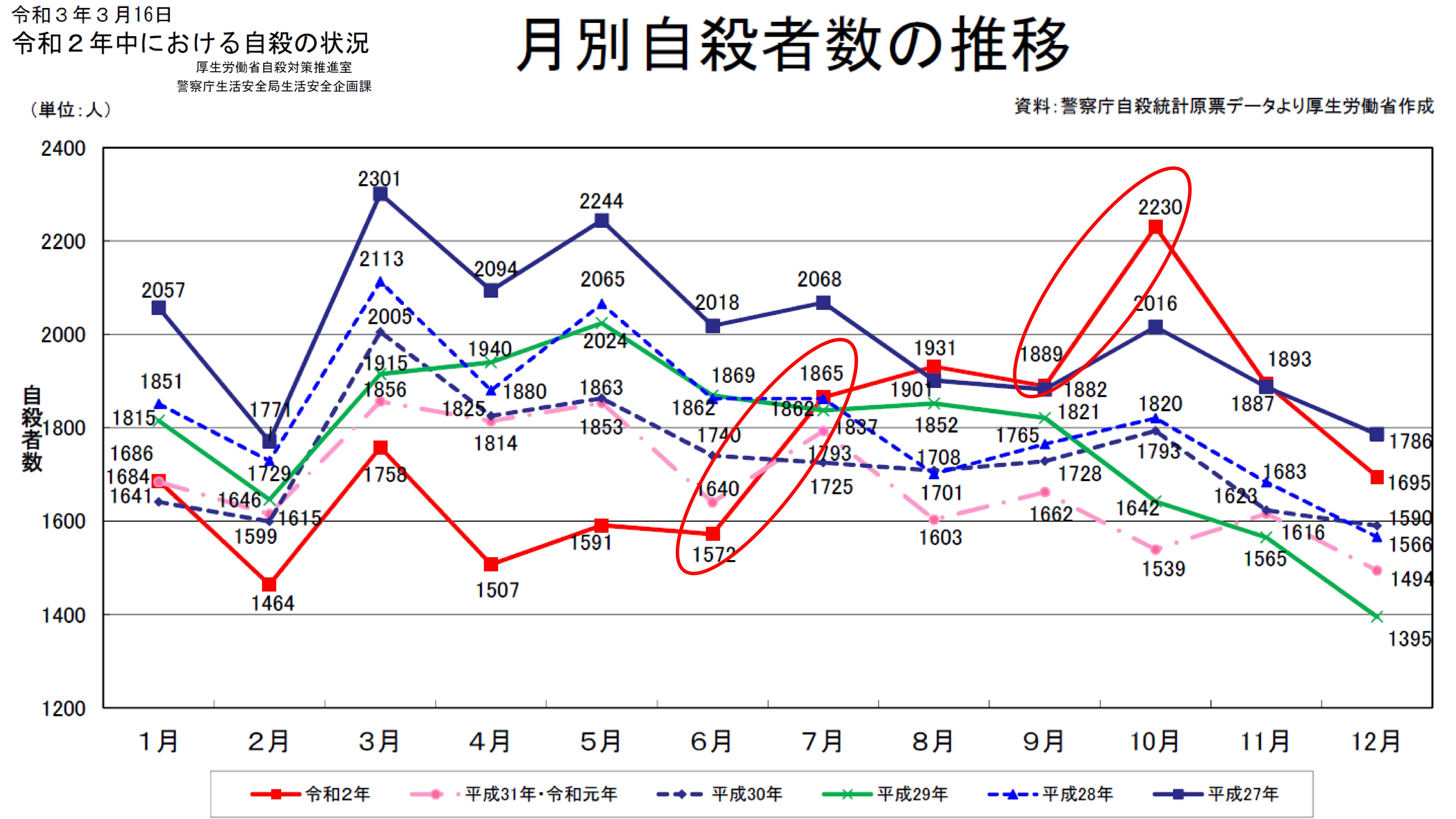
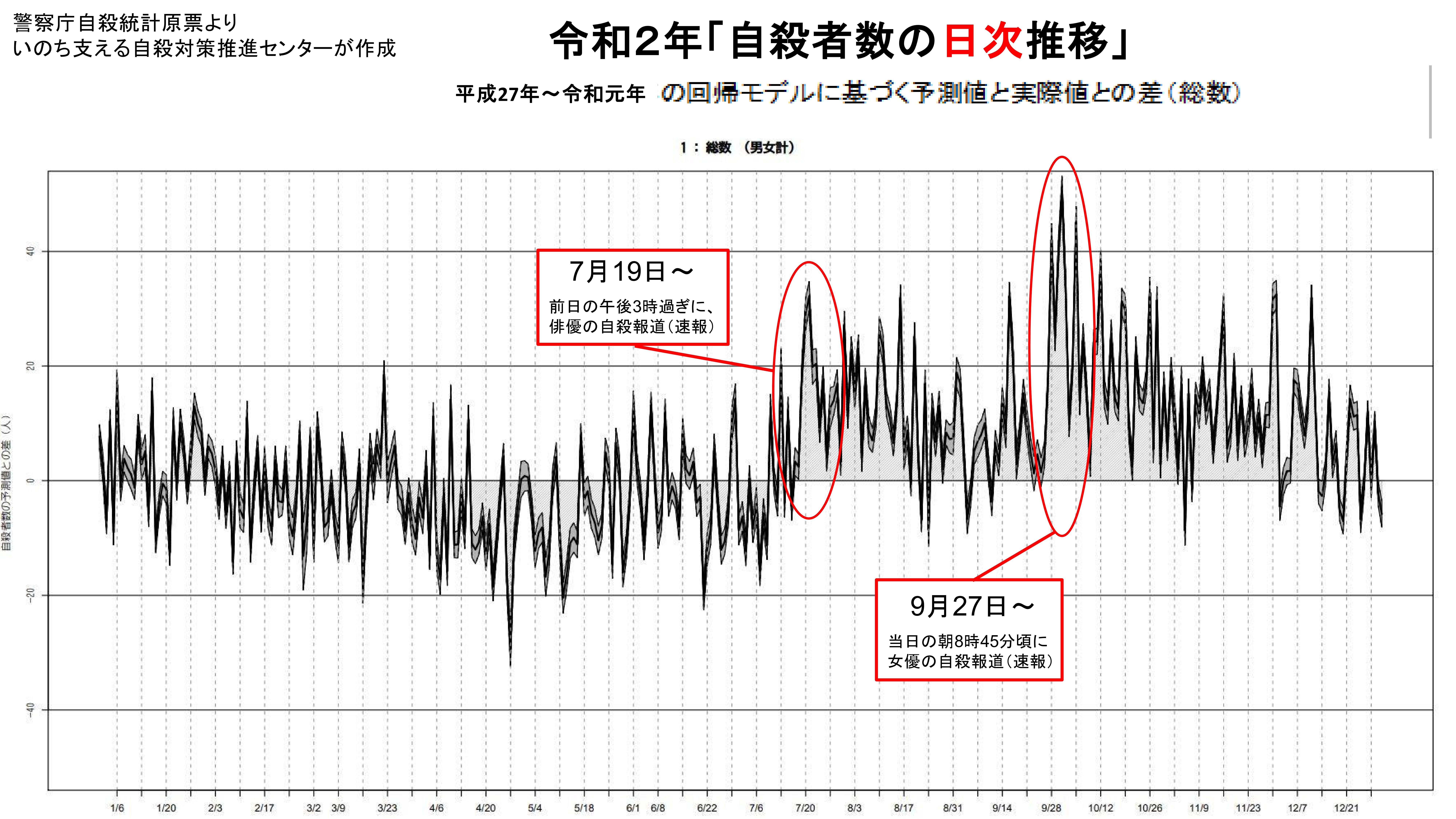
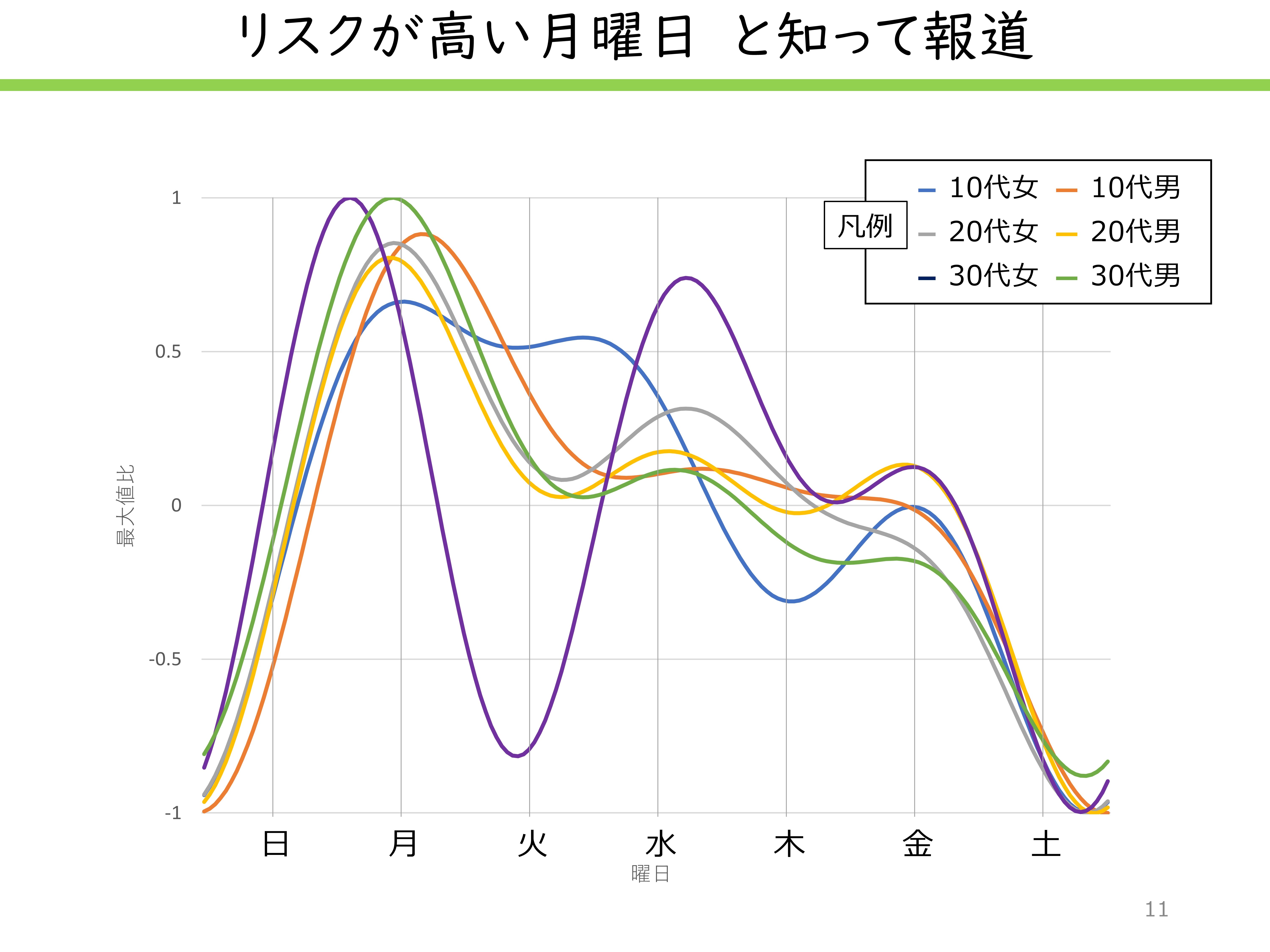 Figure5
Figure5